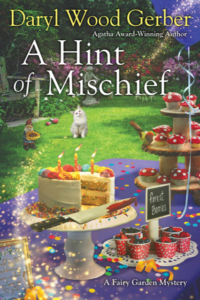Writing a mystery series isn’t easy. Sure, after the first book, the characters are established and the locations have been described, but how can you keep it real and entertaining when a protagonist is stumbling over one body after another? How can you continue to make your readers care about your protagonist if your protagonist feels stale to you? Here are some tips to keep it fresh.
1. Write something else in between.
Think of it like tasting sorbet between the appetizer and entrée. Writing something new gives your brain a rest … or a jumpstart, if needed. Even writing poetry or grocery lists will do. No, I mean it. Writing a grocery list can be really helpful. You’re putting pen to paper. Or maybe you’re typing it on your computer and printing it out. Or maybe you’re adding it to an app that you can refer to in the store. Whatever way you’re doing it, you’re cogitating and plotting and that is what writing is about. Thinking things through. Coming up with answers. I know lots of authors who like to write a short story in between books. If you think about it, writing a short story between 2,000 to 10,000 words seems much less daunting than attempting to write (or rewrite) a book of 80,000 words. It seems “doable.” So give yourself a break. Once you’ve turned in a book or have simply mastered the first draft of a new book in a series, try your hand at something else. Even writing in a diary counts. And who knows? Maybe writing in your diary will flesh out what might be troubling you about the current book.
2. Go back to the original story and figure out why it excited you.
What was the original idea? Did it come to you in a dream? While you were exercising? While you were reading a magazine or newspaper or watching TikTok? Something excited you about the idea. You decided to commit it to paper. You opted to turn into a book of 75,000 to 80,000 words. Why? Was it the story or the character or the theme that mattered? Did you think that you absolutely had to write about motherhood and you landed on a story about mother killing a daughter’s rival? Or was it the rivalry that inspired you? Or was it the idea of protecting the child? There was a nugget that struck you.
If thinking about the original idea doesn’t work, look at the story from your protagonist’s point of view.
Why would he or she want to get involved in this mystery? What is the personal investment? If the protag’s best friend is accused of murder, maybe your theme is really about friendship. Explore the why that got you excited in the first place, and then make it fresh from your protagonist’s POV.
3. Change your murder suspect or victim’s gender.
This sounds simple, but is it? Yes, with some caveats. I’ve written down the plots for all of my books in a log sheet. I look at who was the killer and who was the victim. If I’ve had too many females die in succession, it might be time to have a male victim. But why? Can he die for the same reason the female dies? Can the same kind of killer (shape, size, profession) do the deed? Does the weapon have to change? Does the motive? It’s amazing when you flip the sex of a character how differently you’ll look at a story. I will admit that I’ve done this on occasion simply because I was basing the character on someone I know and worried that he or she might guess, so I changed the sex, and voila, my friend (or frenemy) didn’t have a clue that he or she was the reason I’d created the character.
4. Throw in a B story or special event for the protagonist that requires a lot of attention, making it harder to be a full-time amateur sleuth.
If we just write about the murder, the story can be flat and linear. Find a dead body, solve the crime . . . big deal . . . yawn. Let’s face it. Life goes on around our characters, so throw life at them. A wedding. A 100th birthday party for a beloved grandparent. A hostile PTA meeting. A way-over-budget annual festival. If you divide the protagonist’s attention, she won’t be able to devote all her time to following clues. Therefore, when she does have time, it will feel more pressing.
Consider adding a B story for a secondary character to spice up conflict.
Also, I’ve often found that I can string the two events together. While carrying out her normal duties, my protagonist might land on an activity or tip that can help her solve the murder. Consider adding a B story for a secondary character to spice up conflict. Yes, it can even involve a dispute with the protagonist. But there are other types of conflicts—not just fights and murders. What if her mother is ailing? What if best friend is facing bankruptcy? What if an old boyfriend comes to town? Just remember, life comes at us fast, so it should be the same for your protagonist. To keep things lively, fun, challenging, and rewarding throw in obstacles whenever you can.
5. Give the protagonist someone to care about, someone he or she will want to protect at all costs, and then put that someone in danger.
In every book I write, I try to justify why my protagonist should be sleuthing. Either she cares about the victim or she cares about the person the police think committed the crime. The personal stake helps drive the story and keeps the protagonist in the hunt. However, what happens when the police release the suspect (the protag’s friend/family member/etc.) early on in the story? Can she still be invested? Sure! If she loves her community and wants the town to be safe. If she has pertinent information that she absolutely believes the police should learn. If the suspect suddenly becomes a victim? Justify your protagonist’s reason to be involved. Make her care about the endgame so your reader will care.
Do you write a series? Let us hear about it on Facebook!
 Agatha Award-winning author Daryl Wood Gerber writes the bestselling Fairy Garden Mysteries, Cookbook Nook Mysteries, and French Bistro Mysteries. As Avery Aames, she penned the popular Cheese Shop Mysteries. Daryl also writes the Aspen Adams novels of suspense as well as stand-
Agatha Award-winning author Daryl Wood Gerber writes the bestselling Fairy Garden Mysteries, Cookbook Nook Mysteries, and French Bistro Mysteries. As Avery Aames, she penned the popular Cheese Shop Mysteries. Daryl also writes the Aspen Adams novels of suspense as well as stand- alone suspense. Fun tidbit: as an actress, Daryl appeared in “Murder, She Wrote.” She loves to cook, garden, and read, and she has a frisky Goldendoodle named Sparky who keeps her in line!
alone suspense. Fun tidbit: as an actress, Daryl appeared in “Murder, She Wrote.” She loves to cook, garden, and read, and she has a frisky Goldendoodle named Sparky who keeps her in line!





